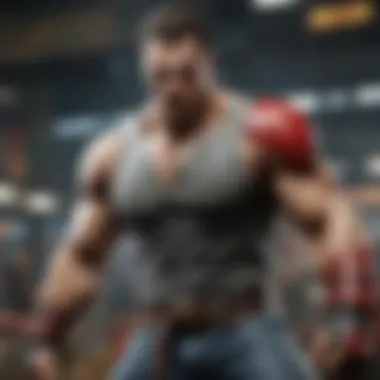Exploring Games Like Tekken: An Insightful Analysis


Intro
Fighting games have captivated audiences for decades, and few series embody this genre like Tekken. This article aims to delve into similar games that echo the elements that make Tekken a household name. By understanding the mechanics, character design, and community involvement, gamers can find alternative titles that offer comparable experiences.
In the following sections, we will explore essential techniques, tips, and insights related to these games. Readers will gain a deeper appreciation of character progression, tactical gameplay, and how different titles contribute to the fighting game landscape. Additionally, we will provide a brief overview of the cultural impact of these games and how they engage their communities.
Intro to Fighting Games
Fighting games are a distinct genre in the gaming world, characterized by their competitive nature and deep mechanics. This article delves into what makes fighting games fascinating, particularly those akin to Tekken. Understanding this genre is crucial for both enthusiasts and newcomers since fighting games are not just about combat but also about strategy, character dynamics, and community interactions.
Fighting games usually involve direct one-on-one combat, where players control characters with unique abilities and combos. The urgency and intensity of these games create an adrenaline rush, commonly found in extreme sports. Players often engage in head-to-head contests that require both skill and tactical thinking.
The Evolution of the Genre
The evolution of fighting games is notable. From the rudimentary pixelated fighters of the 1980s, such as Karate Champ, to the visually stunning and complex mechanics seen in modern titles, the journey reflects technological advancements and changing consumer expectations. Notable milestones include the introduction of 3D graphics in Tekken 3, which revolutionized gameplay and character movements.
As the genre evolved, so did gameplay mechanics. The introduction of combos and special moves created a depth that attracted dedicated players. Each new title released tends to offer innovations in mechanics, graphics, and storylines while building on the foundations laid by predecessors. As a result, fighting games have transitioned from simple arcade experiences to immersive and competitive ecosystems.
Significance of Tekken in This Landscape
Tekken stands as a hallmark in the fighting game community. Its influence extends beyond just its sales figures; it has shaped the genre culturally and competitively. Since its debut, Tekken has consistently pushed boundaries in character design, matchmaking, and storytelling. The complex narrative arcs provide a unique backdrop for the character interactions.
The game is well-known for its innovative mechanics that cater to casual players and skilled competitors alike. Tekken's three-dimensional positioning and intricate combo systems set a benchmark for gameplay depth. This significance is reflected in its global competitive scene, where Tekken tournaments attract large audiences and skilled players.
Understanding Core Mechanics
An in-depth understanding of core mechanics is vital when exploring games like Tekken. This section focuses on the fundamental elements that define gameplay and set the stage for player engagement. Recognizing these core mechanics allows players to appreciate not just the skill involved but also the strategic depth each title can offer. Players on their journey need to note how these mechanics influence both individual play styles and the broader competitive scene.
Combat Systems and Strategies
In the realm of fighting games, combat systems form the backbone of the gameplay experience. Tekken, known for its intricate fighting mechanics, employs a system that balances offensive and defensive actions. Players must master moves, combos, and counterattacks to navigate the fast-paced environment. This balance is not just about player skill but also involves understanding the game physics and timing.
The strategies to succeed in these games often compel players to evaluate specific moves and their effectiveness against various opponents. For instance, the use of frames is critical. Each move has a different speed and recovery period, which influences the player's ability to counter opponents effectively. Additionally, different characters possess unique abilities and move sets, which contribute to various approaches to gameplay. This complexity makes practice essential in finding the most effective strategies for each character.
The Role of Characters in Gameplay
Characters in fighting games are more than just avatars; they embody distinct traits that greatly impact gameplay. In Tekken, each character has a unique backstory, fighting style, and personality, all of which affect how they are played. For players, selecting a character aligns with their individual play style, whether it be aggressive, defensive, or somewhere in between.
Understanding the role of character-specific mechanics can enhance gameplay significantly. Player characteristics like speed, power, and skill set influence the overall approach one takes in combat. For example, picking a character with strong defensive abilities may lead to a more counter-heavy strategy, while a character known for high mobility may encourage a more aggressive, rush-down style. This intricate relationship between character choice and gameplay emphasizes the strategic depth that lies within the mechanics of the game.


Each character’s design impacts player engagement, appealing not only to competitive spirits but also to storytelling enthusiasts.
Key Games Similar to Tekken
In the landscape of fighting games, titles that mirror or expand upon the mechanics and experience offered by Tekken are crucial for both new players and veterans alike. Each game holds the potential to uncover different strategies and styles of play while still fostering a competitive environment. Players benefit from diverse gameplay mechanics, character rosters, and narrative styles, enriching their overall experience. This section delves into several key games akin to Tekken, illustrating their distinctive attributes and contributions to the fighting game community.
Street Fighter Series
The Street Fighter series is a cornerstone of competitive fighting games. Initially released in 1987, it has transformed the gaming world with its iconic gameplay and unforgettable characters. The series emphasizes precision, timing, and deep strategic elements. Players can engage in various fighting styles, as each character brings unique skills and techniques to the arena.
A significant aspect of Street Fighter is its focus on special moves and combos. Understanding how to execute these effectively can make a substantial difference in gameplay. The game also differentiates itself with its unique meter system that governs the usage of special moves and super combos. This strategy invites players to think critically about resource management during matches.
Mortal Kombat Franchise
The Mortal Kombat franchise stands out due to its darker themes and brutal combat mechanics. First introduced in 1992, it has pushed boundaries with its graphic depictions of violence and intricate storylines. The franchise has adeptly evolved, incorporating 3D environments while maintaining its signature 2D fighting style.
Unique to Mortal Kombat are its fatalities and brutalities, which offer a dramatic finish to fights. Players can hone specific characters, each equipped with their own lore and backstory, enriching the engagement factor. The fighting mechanics prioritize timing and skill, echoing the complexities found in Tekken.
Soulcalibur Series
The Soulcalibur series introduces weapon-based combat to the fighting genre. Launched in 1995, it features characters that utilize distinct weapons, offering a varying approach to strategy and range. This series promotes a unique gameplay experience with its emphasis on defensive and offensive stances, allowing players to engage in mind games that elevate the combat complexity.
The character roster is diverse, with each fighter's weapon significantly affecting their fighting style. Players must adapt to the intricacies of each character while deciding when to go on the offensive or defend. The mechanics of Soulcalibur can feel fluid, combining elements of both traditional fighting styles and weapon-based battles.
Dead or Alive Series
The Dead or Alive series is recognized for its fast-paced, fluid combat mechanics and interactive stages. Launched in 1996, this franchise combines traditional martial arts with system mechanics that allow for holds, counters, and multi-directional combat. Each character showcases unique fighting styles influenced by real-world martial arts, which adds depth to combat strategies.
The unique feature of Dead or Alive is its counter system. Players can input specific moves to counter incoming attacks, fostering a deep strategic layer. Moreover, the game introduces a more dynamic environment with destructible stages, further enhancing the immersive experience.
Guilty Gear Series
The Guilty Gear series stands as a testament to the artistic evolution of fighting games. With its anime-inspired visuals, it invites players into a colorful, unique world. Released in 1998, the game showcases frenetic pace and complex character abilities, making it a favorite among aficionados.
Guilty Gear also incorporates unique mechanics, such as the ability to control the pace of the match with additional moves like Roman Cancels and Instant Kill. This depth encourages players to continuously refine their skills and develop their techniques. The series' engaging storyline enriches the emotional connection players have with the characters and their journeys.
Each of these titles contributes significantly to the fighting game community, offering diverse gameplay experiences while resonating with the fundamental elements found in Tekken. Exploring these games can enhance players' strategies, deepen their appreciation for the fighting genre, and foster a sense of community among enthusiasts.
Character Customization and Development


Character customization and development play a crucial role in fighting games, particularly within the realm of titles akin to Tekken. This aspect significantly enhances the gaming experience by allowing players to craft their unique avatars. Not only does this foster a sense of ownership, but it also enables a deeper connection between the player and their character. The ability to personalize attributes, appearances, and fighting styles provides players with the tools to express individuality within this competitive landscape.
One of the key benefits of character customization is the enhancement of gameplay strategies. Different players can create characters that suit their personal play styles, whether they prefer aggressive, defensive, or balanced approaches. This flexibility allows for a more diverse and engaging experience as gameplay evolves. Decision-making in terms of customization often translates to distinct advantages in battle, impacting match outcomes considerably.
Moreover, character development extends beyond mere appearance. Each game typically features a narrative that intertwines with character progression. This narrative depth adds complexity and draws players into the story, making victories feel more rewarding. In essence, character customization and development are instrumental in creating a more immersive and personal fighting game experience.
Creating Unique Play Styles
Creating a unique play style through character customization is a defining feature of fighting games. Players engage in varied approaches based on how they modify their characters. For instance, a player focused on speed may choose light armor and agile moves, while another might opt for heavy-hitting characters with increased defense. This decision-making shapes not only individual combat strategy but also the dynamics of multiplayer interactions.
Several factors contribute to defining these unique styles:
- Move Set Selection: Players can often choose specific moves tied to their character’s abilities. This selection influences the overall combat strategy, allowing for tailored offensive and defensive maneuvers.
- Skill Trees or Traits: Many games incorporate skill trees that allow players to enhance particular aspects of their character, such as strength or agility. This progression fosters a deeper commitment to mastering that character's unique play style.
- Adaptation to Opponent Strategy: As players develop their style, they must also learn to adapt to their opponents’ strategies. Understanding different character builds and their customization can provide significant insight into countering specific techniques.
Through meticulous customization, players can create a character that is not only visually appealing but also aligned with their desired tactical approach. This engagement encourages continual exploration and experimentation within the game.
The Impact of Lore on Character Appeal
Lore profoundly impacts character appeal in fighting games. Players are often drawn to characters whose stories resonate with them. The backstories develop attachment and interest, making the acts of customization and manipulation feel more meaningful. Lore adds context to characters' fighting styles, motivations, and relationships with other characters in the game.
The significance of character backstories can be outlined in various ways:
- Character Origins: Understanding a character's origins can enhance appreciation for their abilities and motivations. For instance, Sub-Zero from Mortal Kombat is not just a combatant; he carries a legacy of a clan focused on honor and vengeance.
- Character Development within the Game: As games progress, characters often experience growth or changes fueled by events within the game's narrative. This evolution can create a deeper emotional connection, as players may feel invested in their character's journey.
- Narrative Integration: A strong narrative makes players more thoughtful about character choices. A skilled character backed by a compelling story will likely attract more attention and engagement compared to a character lacking such depth.
Ultimately, the integration of lore enhances the character customization experience. It enriches player investment and provides context for customization decisions. As players delve into fighting games like Tekken, the interplay of customization options and character lore cultivates a robust gaming environment.
"Character customization and development not only transform gameplay but also shape players' emotional connections to their characters, fostering an immersive experience in fighting games."
Competitive Scenes and Community Engagement
Competitive scenes and community engagement are crucial elements in the world of fighting games, serving not only as a measure of their popularity but also as a driving force behind their evolution. They create a vibrant ecosystem where players can connect, share experiences, and advance their skills. These aspects enhance the longevity and attractiveness of games like Tekken, effectively weaving a fabric of camaraderie and rivalry.
The Rise of Esports
The ascent of esports has transformed fighting games into a spectacle, engaging vast audiences worldwide. Tournaments such as Evo and Capcom Cup have showcased the skills of top players, elevating the status of games like Tekken from casual to elite entertainment. This shift has encouraged developers to invest more in competitive features, refining mechanics and balancing gameplay to cater to a pro environment. The presence of sponsorships and streaming platforms has created additional avenues for visibility, further solidifying esports as a legitimate career path for many players.
Local and Global Tournaments
Local and global tournaments are pivotal in fostering community interaction. They provide players with platforms to test their mettle against others, promoting skill development and learning in an environment of support and competition. Each region becomes a hotbed for talent, where rivalries can form, and friendships can blossom. Events such as those hosted by community organizers often play a crucial role in strengthening ties among players. They ignite a passion for the game, with participants returning to improve and often contributing to the scene long after their initial involvement.


"Tournaments are where the best players are born, and dreams can become a reality."
Fan Culture and Community Contributions
The fan culture surrounding fighting games is vibrant and steeped in enthusiasm. Dedication manifests in various forms, such as fan art, tutorials, and even community-driven tournaments. Forums on platforms like Reddit and Facebook allow players to share experiences and strategies. Such contributions enhance the collective knowledge base and foster a sense of belonging within the community. Fans also play a substantial role in providing feedback to developers, influencing future updates and iterations of the games they love.
In summary, competitive scenes and community engagement not only strengthen the identity of fighting games but also cultivate a rich environment that encourages player participation and growth. The dynamic interplay of competition, regional rivalries, and fan contributions ensures that games like Tekken will continue to thrive, providing new layers of experience for thrill-seekers and enthusiasts.
The Future of Fighting Games
The future of fighting games holds immense potential as a unique combination of technology, creativity, and community engagement continues to evolve. The genre has witnessed significant transformations over the years, driven by advancements in gameplay mechanics and emerging technologies. Understanding these trends is critical for players and developers alike, as they shape not just the games we play, but also the culture surrounding them.
Innovations in Gameplay
Innovations in gameplay are reshaping how fighting games are made and experienced. Game developers are constantly experimenting with new mechanics to enhance competition and engagement. One noteworthy trend is the incorporation of hybrid models that blend traditional fighting with elements from other genres, such as role-playing games or battle royales. This creates a more diverse experience for players, inviting deeper exploration into character abilities and strategies.
Moreover, the focus on accessibility has never been greater. Developers are looking to simplify control schemes without sacrificing depth. For instance, games like Dragon Ball FighterZ have made complex combos achievable for casual players while maintaining a tier for advanced users to master. Such an approach allows for a wider audience to engage with the genre.
Another emerging trend is the use of artificial intelligence to adapt gameplay. Machines can learn from player behavior and tailor challenges accordingly, leading to dynamic PvE experiences that enhance skills over time. This not only provides a more personalized journey for players but also keeps them coming back for more.
Developments in Virtual Reality
Developments in virtual reality (VR) are poised to bring fighting games into a new era. The immersive nature of VR can transform the way we experience combat, enabling players to engage in battles as if they are physically part of the game. Titles like Beat Saber have shown that rhythm-based movement can generate excitement. Imagine applying that concept to a traditional fighting context, allowing players to dodge, attack, and block in a fully immersive environment.
Furthermore, VR technology is facilitating innovative ways for players to train and improve. In a simulated environment, players can practice techniques and strategies without the pressure of competing against others. This unique training medium could lead to better skill development among players, thus elevating the overall competitive landscape.
As these technologies continue to mature, it is crucial for the fighting game community to embrace and adapt to the changes. The future of fighting games may very well depend on how seamlessly developers can integrate new techniques and technologies into their offerings, providing a rich and engaging experience for players.
The ongoing evolution in gameplay and technology not only enhances the player experience but also expands the fighting game community.
Finale
The conclusion serves as an essential element within this article, encapsulating key understandings while emphasizing the broader implications of exploring fighting games like Tekken. It allows readers to reflect on how these games not only offer entertainment but also foster skill development and strategic thinking. The fighting game genre is a complex matrix of mechanics, narratives, and community dynamics. Recognizing this complexity can deepen appreciation for the games that define it.
Reflecting on the Fighting Game Landscape
In recent years, the fighting game landscape has undergone significant transformation. From the rise of esports to the development of online communities, the way we engage with fighting games has shifted. Titles like Tekken have set benchmarks in gameplay, yet many other games also contribute to this evolution. They introduce new mechanics, storylines, and character interactions that challenge and enhance player skills.
Moreover, the rise of streaming and content creation platforms has elevated these games' visibility. Players now share techniques, strategies, and experiences, further enriching the discourse surrounding fighting games. This environment not only benefits seasoned players but also attracts newcomers. A diverse range of fighting games allows audiences to explore different combat styles and mechanics, fostering a culture of continuous learning and competition.
Encouragement for Discovery
As technology and creativity converge, the opportunities for exploration within the fighting game genre are immense. Players are encouraged to seek out titles beyond Tekken. Engaging with games like Street Fighter or Mortal Kombat can uncover unique gameplay mechanics and narratives that may resonate on personal levels. This journey of discovery is fundamental for any gamer seeking to expand their knowledge.
In summary, the exploration of fighting games fosters not just enjoyment, but also a critical understanding of the genre's depth. Exploring the myriad options available can unveil hidden gems and broaden the gaming experience. The gaming community continues to thrive, pushing boundaries and challenging conventions. The many avenues for exploration within this genre promise to captivate thrill-seekers, ensuring that every player finds a challenge that resonates with their gaming aspirations.







